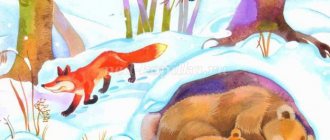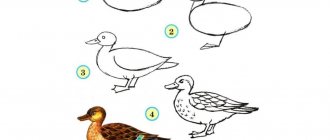Hedgehog
A narrow muzzle, a black nose, beady eyes, and most importantly, a “fur coat” with prickly needles. This is what this forest dweller looks like. The needles are needed so that the animal can defend itself from enemies - the hedgehog curls up into a prickly ball in case of danger. Basically, hedgehogs sleep in a hole or bushes during the day, and in the evening they lead an active lifestyle - they go out hunting. Sharp claws, spines and teeth help the hedgehog even catch a snake. Hedgehogs also eat insects, amphibians, caterpillars, worms, as well as fruits and berries.
They often live close to people - perhaps because we feed them. But you shouldn’t pet hedgehogs or pick them up - not only can you get hurt, but these animals are also carriers of dangerous diseases, including rabies. And you should not try to keep a hedgehog at home - it is a free animal.
Hedgehogs spend the winter hibernating in their burrow under tree roots, branches or stumps. The hole is prepared in advance when it starts to get colder. They drag grass, moss and leaves there to make it warm and cozy to sleep. And in the fall, hedgehogs feed intensively, accumulating fat for the winter.
Hedgehogs are born in the spring - like the cubs of many animals, they are toothless, blind and deaf. Hedgehogs feed their children milk and hide them under grass and leaves during their absence. After a year, hedgehogs become completely adult and independent.
Lynx
Meeting this large yellow-red forest “cat” with the famous “tassels” on its ears is a great success. Even hunters encounter lynx extremely rarely. At the same time, it does not pose a danger to humans, unless it is suddenly infected with rabies.
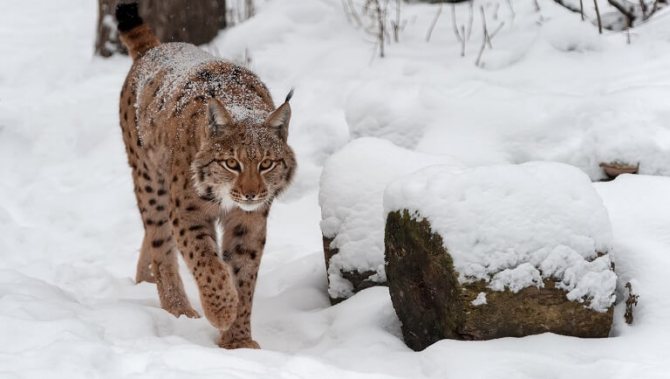
The lynx is flexible, dexterous and strong, and can climb trees and swim well. And deep snow is not a hindrance for her - because of her strong, furry paws. The lynx is also cunning - sometimes it checks the traps and traps of hunters before they themselves and drags away other people's prey. Sometimes it can wait for hours for a prey (hare, deer, roe deer, bird) in ambush, then quietly and unnoticed to sneak up and jump on it. If you can’t catch it the first time, the lynx can hunt for the same animal all day long. By the way, when entering the countryside, the lynx also hunts cats - almost their own kind.
Lynxes prefer to settle in secluded places - for example, in holes under trees. They are not shy about occupying other people's holes.
Lynx cubs are furry and blind for the first few days. By the way, both parents raise lynx cubs, and this is a rather rare case in the animal environment.
Bear
A large, strong animal with dark brown or brown fur and clawed paws - everyone seems to know what a bear looks like. In fairy tales he has the “image” of being clumsy and clumsy. In fact, bears living in the forest are very dexterous, they can move almost silently - even run - and climb trees. Bears eat berries, nuts, fruits, oats and insects. They love to catch fish directly with their paws.
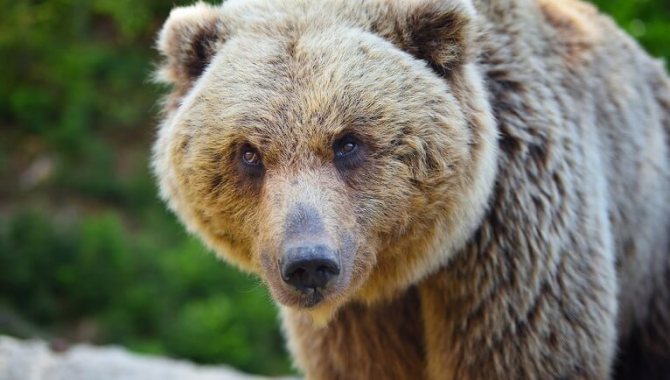
By the way, everyone knows the expression “suck a paw” - they usually say this, meaning “get by with little”, and sometimes “sit without money”. It is believed that bears suck their paws (literally) in their sleep when they are waiting out the winter in a den - in a hole covered with snow, under the roots of a fallen tree, or in a pile of brushwood. They don't actually suck - perhaps they just warm their paws with their breath.
The cubs are born blind in the middle of winter and emerge from the den in the spring, fed with the milk of their mother bear. In addition to the mother, the cubs are looked after by a nurse - that's what they call a nanny - the cubs' older sister. “Children” are usually playful, climbing trees and tumbling.
Nevertheless, it cannot be said that bears are so good-natured. This animal will not attack a person just like that, but if, for example, you disturb it in its den or if the she-bear decides that you pose a danger to the cubs, an unexpected meeting in the forest can end in disaster. Experts advise travelers to avoid dense bushes and thickets in the forest, if possible, talk loudly and sing while walking - this way you will not take the bear by surprise and avoid danger.
Boar
Powerful and strong fanged boars, the ancestors of pigs, look menacing and are therefore considered very dangerous. In fact, a healthy boar, like many other animals, can attack a person only if there is a need to defend itself or protect its cubs. But wounded and sick boars are really aggressive and unpredictable. Be that as it may, you can’t run away from them, just like you can’t come closer, look into their eyes, or turn your back. When meeting a wild boar, you should behave calmly. But, most likely, the meeting will not happen - the boar will hear you from afar and leave on its own.
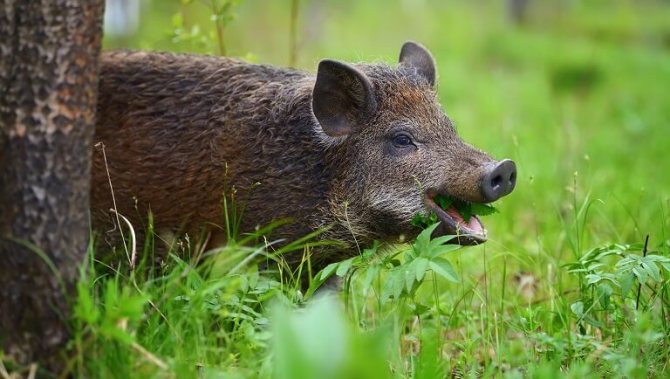
This animal runs quickly - the structure of its hooves allows it to overcome even swamps without getting bogged down - and swims across any rivers. But it is difficult for a wild boar to move in deep snow. At the same time, he does not freeze in cold weather - by winter he develops a thick undercoat and accumulates fat.
Wild boars live in small groups. They eat hazelnuts, seeds, acorns, plant tubers, and enjoy mushrooms, berries, apples and pears. Sometimes they dig up potatoes or turnips from summer cottages. Piglets are given birth in a den hidden by moss and branches. On the backs of the babies there are light stripes, because of which the cubs are not visible among dense thickets and in bright light, as well as in the shade.
Like pigs, wild boars love to bathe in mud - this is how they escape the heat and get rid of insects clinging to their coarse fur.
Wolf
The wolf that lives in the forest looks like a shepherd dog - not surprising, because it is from the wolf that all dogs trace their ancestry. But you can still distinguish a wolf: it is larger than a dog and never curls its tail into a ring. And he doesn’t bark, but howls or growls. His fur is gray or reddish, thick and warm.
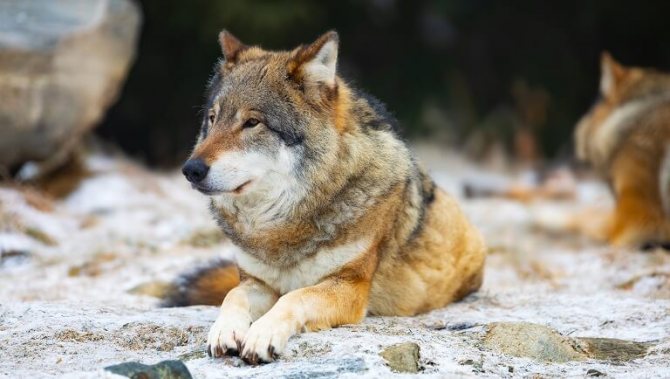
In fairy tales, the wolf is considered a treacherous, formidable and evil animal. He received such “fame” because he is a predator - he feeds on the flesh of animals caught during hunting: roe deer, hares, foxes, badgers, mice, marmots, wild geese and others. Sometimes wolves even kill their own kind.
Berries, fruits and mushrooms are also included in the wolf's diet. Sometimes wolves steal watermelons and melons from farms - all because these animals are often thirsty: they have a high need for water.
Wolves hunt mainly in packs - and not where they live. Even if the wolf's den is located near a farm or village, the animals will not give themselves away, because they will hunt far away - perhaps kilometers - from the “place of residence.”
When you see a wolf in the forest, it is better to retreat quietly, without looking him in the eye, or leave altogether. At the same time, it should not be considered a “bad” animal - it is a dexterous, fast, smart and strong animal. Wolves are also good parents: she-wolves feed their cubs with milk and always protect them from danger. Wolf cubs are born deaf and blind, so at first they are completely defenseless. When they grow up a little, their parents bring them live prey - not only for food, but for play and passive “hunting”.
Wolverine
This animal is a kind of cross between a sable, a badger and a bear, and is the size of a dog. Powerful head, sharp teeth, thick clawed paws.
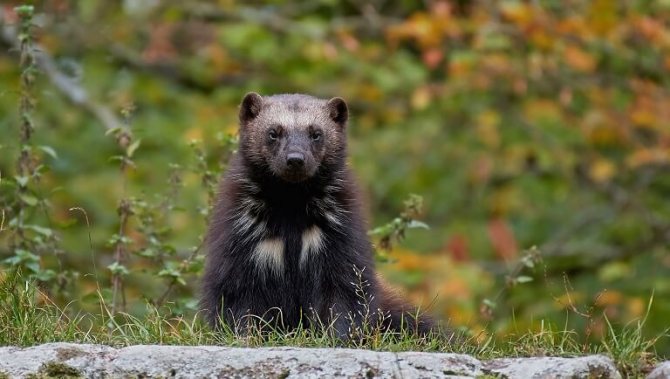
Despite his somewhat clumsy appearance, wolverine is flexible, agile and strong. And it is quite cruel - it attacks sick animals, destroys nests, and often feeds on carrion. Its diet also includes snakes, lizards, and fish (the wolverine is an excellent swimmer). It is protected from enemies by iron with a nasty smell, with which it scares off larger animals so much that sometimes they not only do not attack, but even throw their own prey to the wolverine. She also willingly “cleans up” traps and pitfalls set by hunters. Yes, even a loud picnic, especially at night and with attractive aromas of food, may well be visited.
However, she is also capable of hunting herself - she has acute hearing and vision, a quick reaction, and is able to pursue even a large deer for a long time and persistently, and then attack from behind. If an animal, even many times larger than the wolverine itself, is weak and sick, she will not leave him a chance. The wolverine goes hunting at night - it can navigate perfectly in the dark.
The lair is made under the roots of an uprooted tree or away from prying eyes. Doesn't stay anywhere for long, constantly on the move.
Wolverine cubs are born at the end of winter, and in the summer they follow her on a long journey. Their mother skillfully teaches them to hunt and protect themselves from enemies. It is better not to approach wolverine cubs - the mother can attack a person while protecting her offspring. At the same time, once a wolverine puppy gets to a person, it will probably get used to it and become obedient.
Fox
Dexterous, cunning and smart - this is how the fox appears before us in fairy tales and fables. Indeed, this animal often lives not far from people - not in a dense forest, but closer to the edge, and sometimes near fields and ravines - but does not give itself away. The fox is also very observant: for example, it is not afraid of dogs sitting on a chain, or people working in the field who do not notice it.
But if she is suddenly in danger, the fox disappears quickly, practically sprawling above the ground as she runs, and it is extremely difficult to catch her. When running and jumping, the fox's tail helps it maintain its balance - it is fluffy and red, sometimes white or black at the tip. The fox has red fur, a narrow muzzle, and black paws and ears.
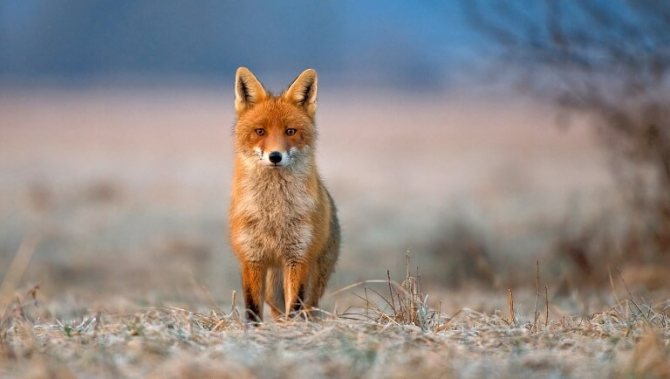
Unlike wolves, foxes love solitude and do not gather in packs. They feed mainly on mice. In winter, foxes run through snow-covered fields and listen for a mouse squeaking somewhere so they can grab it. Foxes have excellent hearing, as does their sense of smell. But the vision is not very good.
Foxes also hunt hares, destroy bird nests, eat insects, snakes and frogs, and deftly carry chickens from farmers. And they don’t disdain berries and fruits.
Foxes breed in burrows. Moreover, sometimes they do not dig holes themselves, but are occupied by strangers - and at the same time they make backup passages just in case. The foxes feed their cubs - blind, deaf and toothless - with milk. Grown-up fox cubs are curious and do not stay in the hole for long - they are drawn to explore the surrounding space. True, they hide back in the hole at the first maternal “command” - yapping.
Foxes don't like meeting people too much, so if a fox suddenly approaches you on its own, this is a bad sign. Maybe she's mad. If there is no place to hide, try climbing the nearest tree, distracting the fox by throwing food (if you have it), or letting it grab onto a stick.
Hare
In fairy tales, we are used to seeing the hare as cowardly and stupid. In fact, this is an intelligent and nimble animal that can throw both a fox and a person off the scent. Perhaps the hare is considered cowardly because he often hides in the grass or bushes, catching a sound that alerts him with his large ears, and with quick long jumps runs away from enemies who still managed to detect him. Sometimes the hare suddenly returns in its own tracks and jumps far to the side - so there are more tracks, and it is no longer clear where the animal went.
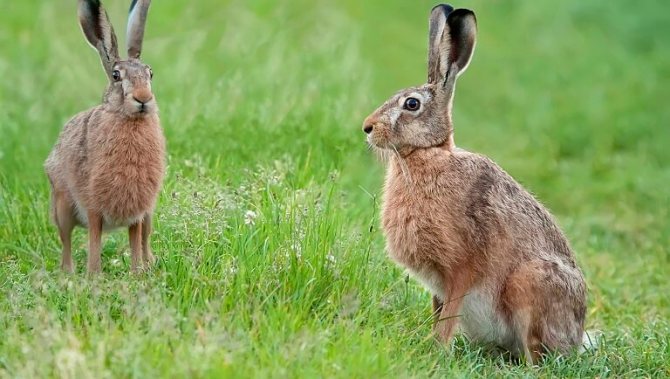
The hare's eyes are located on the sides of its head, which is why it is called “slanty”. But thanks to this feature, he can see what is happening not only in front of him, but to the side and even behind.
The snowshoe hare turns white in the winter to blend in color with the snow. The brown hare, which lives in the fields and steppes, is gray all year round, and by winter it also brightens, but not so significantly.
The main enemies of hares are foxes, wolves and birds of prey. During the day, in the light, the hare hides from them alone, and comes out to eat in the evening or before dawn. Hares feed on grass, branches, plants, and in winter, tree bark. Crops from gardens are often stolen.
Hares have sharp teeth and long, sharp claws. Contrary to stereotypes, it happens that wild hares kill foxes, and not vice versa. Sometimes a hare can even rush at a person, but only for self-defense. If you don't offend the animal, it will most likely simply hide when it sees you.
The little hares feed on their mother's rich milk, but if she suddenly leaves on business, then they feed on the milk of another hare. They grow quickly.
Beaver
For many centuries in a row, the largest rodent in Russia - the common beaver - was a target for hunting: people were attracted by its skin, meat, fat and even secretions of the musk gland, which have healing properties. It was easy to find beaver settlements, since the animals settled in groups of 5–8 animals, often near the water. Over time, the beaver population has thinned out.
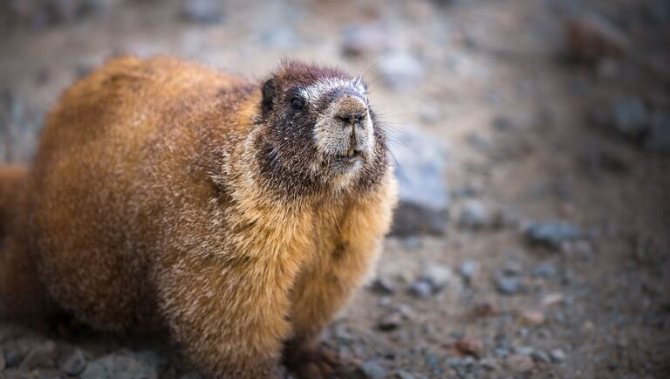
The beaver is a squat, densely built animal, its body length is about a meter, its fur color ranges from chestnut to dark brown, less often black. A beaver's hind legs are much stronger than its front legs.
Smart, hardworking beavers love to build holes or huts from branches, sticks, clay, silt, and always with an exit under water. In the aquatic environment, these hard workers are more comfortable and safer, and on land they move less willingly. The beaver also stores its reserves in the water, not far from the hut, and in winter it gets enough so as not to go onto land.
Dams built by beavers prevent water bodies from drying out. And beavers need dams to raise the water level and make their homes comfortable.
Beavers are herbivores - they eat more than 300 species of plants. They love tree bark and coastal water lilies and reeds. With its sharp teeth, a beaver can even gnaw through a tree, and sharpens them on some types of trees.
Beaver cubs are born in April-May, and there can be up to six of them in a litter. At first they feed on mother’s milk, after a couple of weeks they can already eat plants, and over time they switch to plant foods completely.
Despite the fact that newborn beaver cubs already have good vision, are covered with warm down, can swim and have teeth, beavers live with their parents for up to two years.
The beaver is generally not dangerous to humans. Bites extremely rarely. And yet, you shouldn’t try to feed it or take a photo - when you meet an animal, it’s wiser to stand and wait for it to swim away.
Elk
Elk is just as large and powerful, but, according to many, not as luxurious an animal as deer. Also wide horns (protection from wolves and bears), but - a hump on the nose, a thick upper lip, a massive body with a “hump” that forms the scruff of the neck... And also long ears, thick warm fur and large hooves.
Thanks to these features, moose do not freeze in winter, hear perfectly, move through deep snow, can swim and run quickly - including through dense forests and swamps.
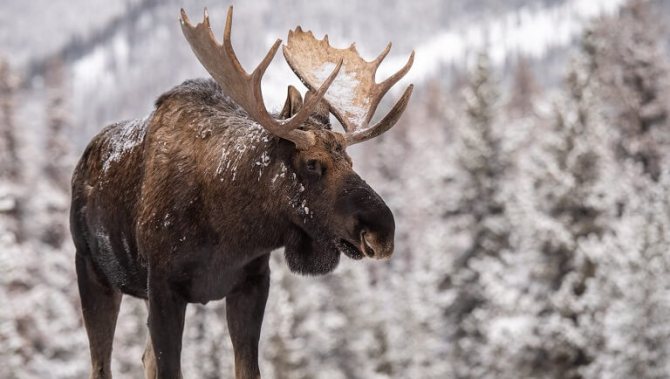
Moose feed on everything they find in the forest: leaves, bark, branches, pine needles, moss, mushrooms, berries and plants growing near water. By the way, moose love to swim, especially in the heat.
In winter, moose shed their antlers to grow new ones in summer.
In the spring, moose cows give birth to cubs, feed them milk and lick their fur. Moose milk is considered healthy. When a moose cow walks with a “child,” it is better to avoid her: in order to protect the calf, she may attack.
Moreover, there are even moose farms where moose are milked - that is, they can actually be tamed.
Moose can be found not only in the forest - it can even wander into a city park (for its love of walking, it is called a tramp). As with other wild animals, the main thing is not to attract attention to yourself, do not get close or run away.
Are you learning English with your child? In this article we have compiled a list of animals in English for grades 2-3 with translation, transcription in Russian letters and colorful illustrations. And simple riddles about animals will help you consolidate your knowledge.


